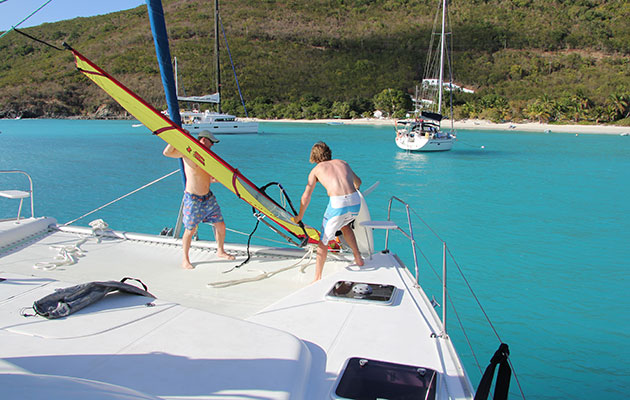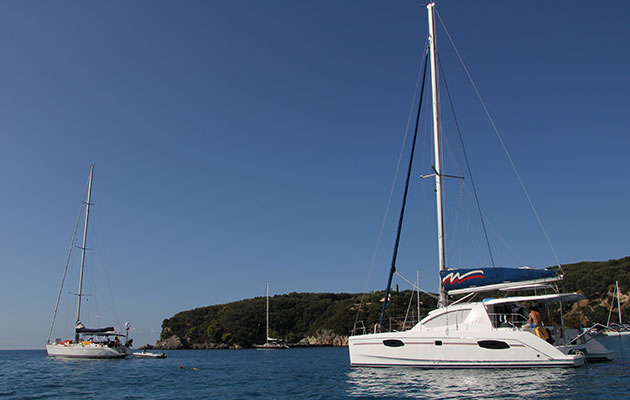As former editor of Yachting World, David Glenn has plenty of experience of both monohull and multihull cruising. Here he weighs up the pros and cons
Through the binoculars I could see masts off Basil’s Bar on Mustique. Their lack of movement suggested a fine anchorage, sheltered from the tradewind-driven swell that builds up in the channel between Mustique and Bequia. It soon became apparent that most belonged to cats, immune from the rolling monohulls like ours would endure if we were to stop in this otherwise enticing bay.
More anchorages in a multi

Cats galore off the Soggy Dollar Bar, Jost van Dyke: too shallow for a fixed keel monohull of similar size
Stability is one of the truly great advantages of a cruising multihull. Not just at sea where the tiresome business of heeling is something that simply doesn’t – or shouldn’t – happen to any great extent, but at anchor too. It dramatically widens one’s choice of anchorages to include those affected by swell – not uncommon in the Caribbean, for instance, where a subtle change in wind direction can make a previously flat calm anchorage unbearable in a monohull. Its comparatively shoal draught widens the choice still further.
I grew up with monohulls, own one, and frankly wouldn’t consider a multihull for the sort of sailing I do. In northern European waters, marina berthing is a regular necessity and completely safe open anchorages are few and far between.

No rolling or heeling, 360° views and one-level living, as here on a Lagoon 52, appeal to many
But if I were to undertake some serious blue water cruising and I wanted family and friends genuinely to enjoy being afloat, particularly those less experienced, a multihull would have to be a consideration. I would have to put aside the question of aesthetics – let’s face it, they’re ugly beasts – and forego that unique and satisfying sensation of a yacht sailing well, because to date I have not experienced it in a cruising multihull. And that’s quite a sacrifice.
More space in a multi
My attitude changed after chartering catamarans in the Caribbean and Mediterranean. The need to accommodate two families comprising largely of teenage children made the choice of a multihull a no-brainer. In a 46-footer we could accommodate a party of 10 in comfort and the paraphernalia demanded by youth, like surfboards, windsurfers, kites and snorkelling kit, without feeling jammed in.

One-level living makes a big difference when sailing as a famly
The cavernous berths in the ends of the hulls, the wide saloon-cum-galley with its panoramic view and the inside/outside lifestyle made possible by the juxtaposition of the big aft deck and the same level saloon, got the entire crew onside instantly.
As an outside living space, with a trampoline at one end and a massive aft deck at the other, there is simply no comparison with a monohull of the same length. So space, linked to stability, makes for an experience that everyone, even the timid and novices, will find hard not to enjoy.
No speed difference

A multihull, like this Moorings 46, has abundant stowage on deck and below, but filling it all will slow her down
Load-carrying ability is a double-edged sword. On the up side there is room for a big crew and its kit, much more fresh water tankage than a monohull, eliminating the need for an expensive, temperamental watermaker, and finding space for a generator should be easy.
On the down side the temptation to overload will probably cancel out any perceived performance advantage. Multihulls can be relatively quick in the right offwind conditions, but if they are heavily laden – as they will be for blue water cruising – there really is no significant speed advantage.

The Gunboat 66 Phaedo 1 piles on the speed, but for blue water cruisers, comfort and stowage is more important than pace
Some new designs such as Gunboat and Outremer have concentrated on performance, but most clients aren’t overly concerned about outright speed and are happy to trade performance for the considerable comfort offered by brands like Lagoon, Broadblue, the Fontaine Pajot stable, Leopard, Catana, Privilege and others.
Mono sails better

Monohulls, like this Amel 55, sail better upwind, and her ballast keel adds displacement, which means comfort when it’s rough. Multihulls can develop an unpleasant motion in a big sea
Upwind, most cruising multihulls won’t point like a monohull with a deeper keel, and when it gets lumpy and fresh, the motion can become distinctly unpleasant. You have to keep a particularly careful eye on sail area too, but more of that in a moment.
In 2011 I was involved in a test of three cruising catamarans and among my fellow judges was multihull design legend Nigel Irens. He pointed out that catamaran buyers have voted for accommodation (which means weight) over performance, so the dilemma of mixing the two has largely disappeared. With it went the spectre of capsize because, relative to their displacement and beam, the modern cruising catamaran is under-canvassed. But that doesn’t mean that sailors can simply set sail and go in any weather.
‘Speed limits’ on a multi

On a multihull, it’s more important to know when to reef. Set speed limits and stick to them
Also on the panel was Brian Thompson, the lone Brit on board the 130ft French trimaran Banque Populaire V that sailed around the world in under 46 days. He told me that the tell-tale signs for knowing when to reef are far more subtle on a multihull. Apart from instinct, Brian suggested monitoring boat speed closely and having a speed limit to trigger reefing. It is easy to overlook a building breeze when bowling along downwind in a multihull, which is going faster and faster. ‘Keep your boat speed within safe limits you should not get into too much trouble,’ he said.
People often ask about anchoring a multihull, which is important as a multihull will spend a lot of time at anchor. Squeezing into a marina can be nigh on impossible, and expensive if you can get in. An essential piece of kit, which should be standard with a new boat, is a bridle that runs from either hull and keeps the anchor cable on the centreline. In many ways this is easier than anchoring a monohull as it prevents the ground tackle from fouling the hulls.
If you do get alongside a marina pontoon you will soon discover another modern cruising multihull issue: excessive freeboard. It’s worth investing in a portable ladder for those marina moments. Of more concern is MOB recovery. There are bathing platforms on both hulls of most new boats, but it’s not the place to be if a yacht is pitching in a heavy sea. So considerable thought needs to be applied to retrieving an MOB if the worst happens.
The recent and dramatic increase in numbers of multihulls going blue water cruising is certainly testament to their appealing ‘lifestyle’ attributes, but one must bear in mind that they are not a fix for all liveaboard cruising challenges. It’s just a different way of doing things. The elements remain the same and can inflict just as much punishment for the unwary on a multihull as they can on a monohull.
Enjoyed reading this?
A subscription to Yachting Monthly magazine costs around 40% less than the cover price.
Print and digital editions are available through Magazines Direct – where you can also find the latest deals.
YM is packed with information to help you get the most from your time on the water.
- Take your seamanship to the next level with tips, advice and skills from our experts
- Impartial in-depth reviews of the latest yachts and equipment
- Cruising guides to help you reach those dream destinations
Follow us on Facebook, Twitter and Instagram.




